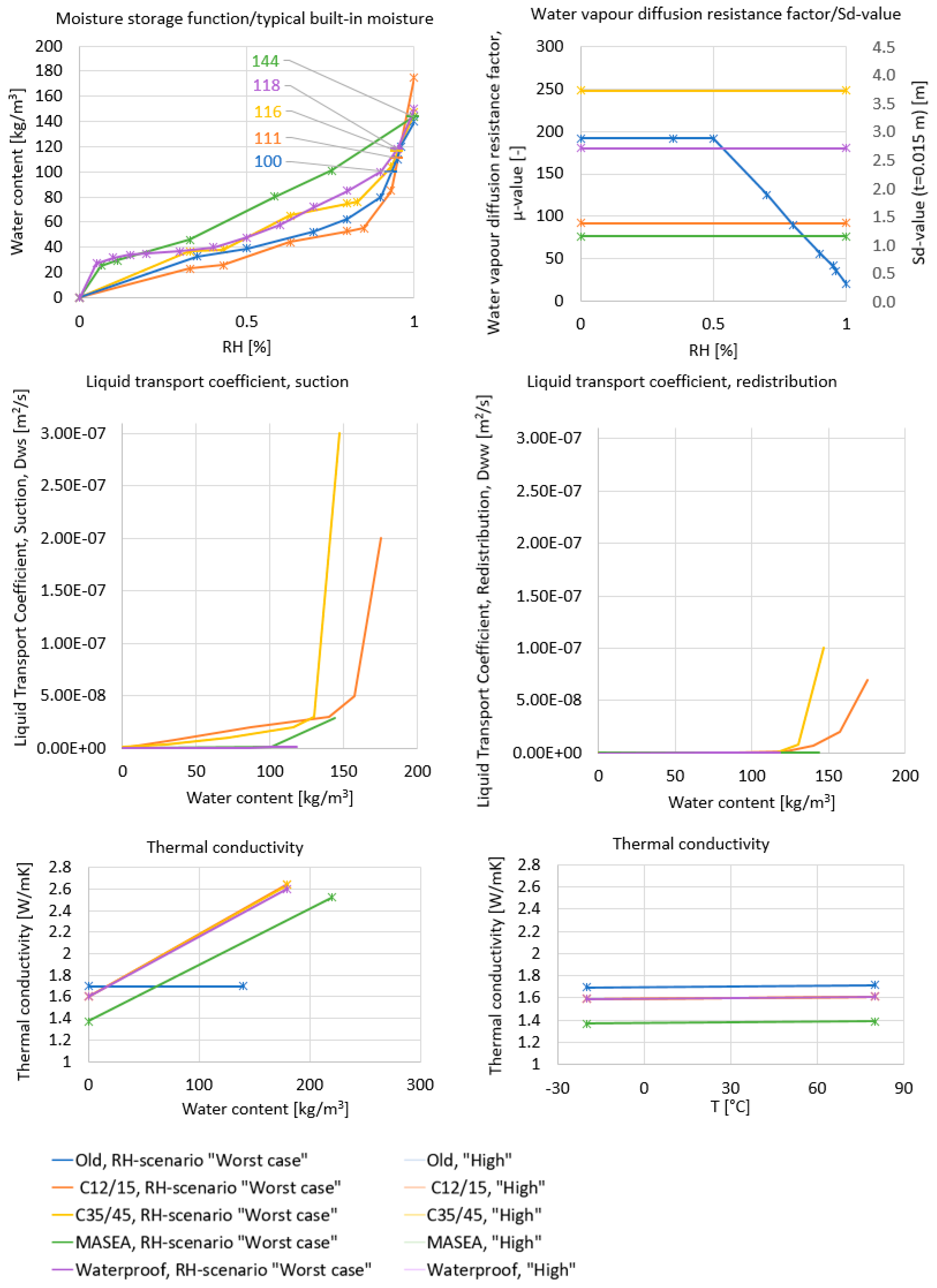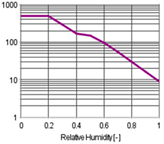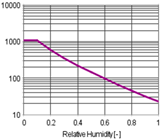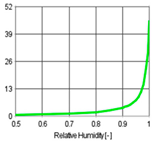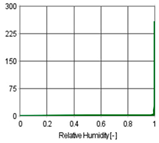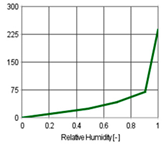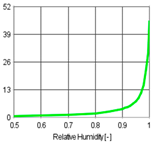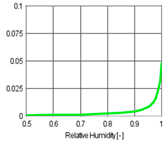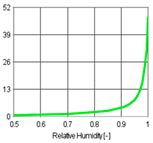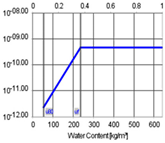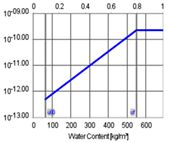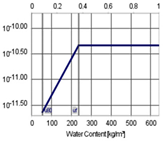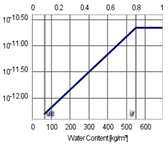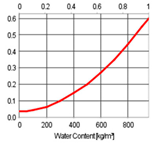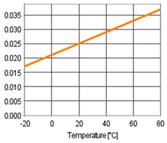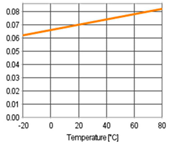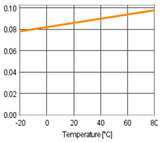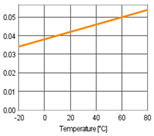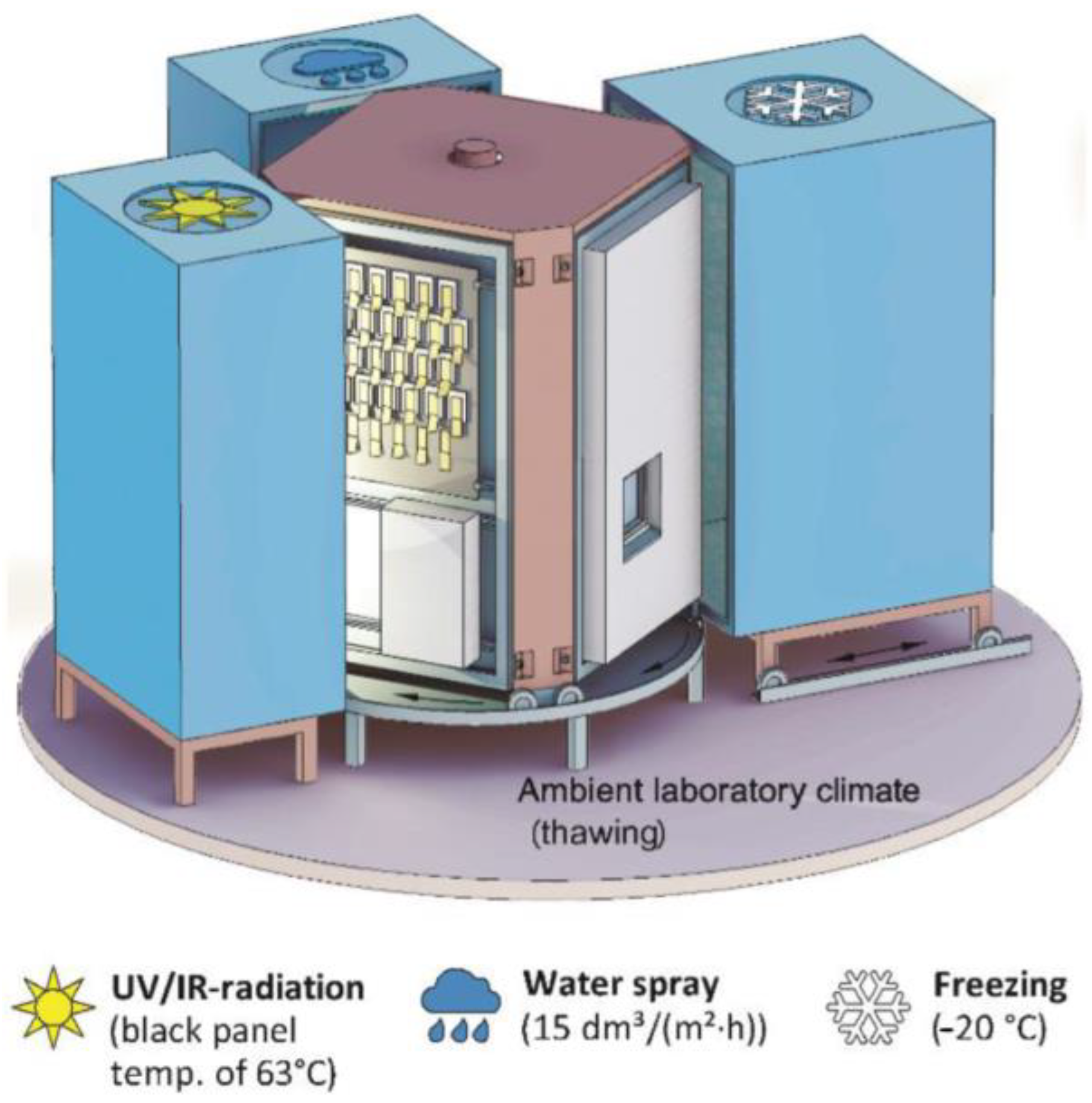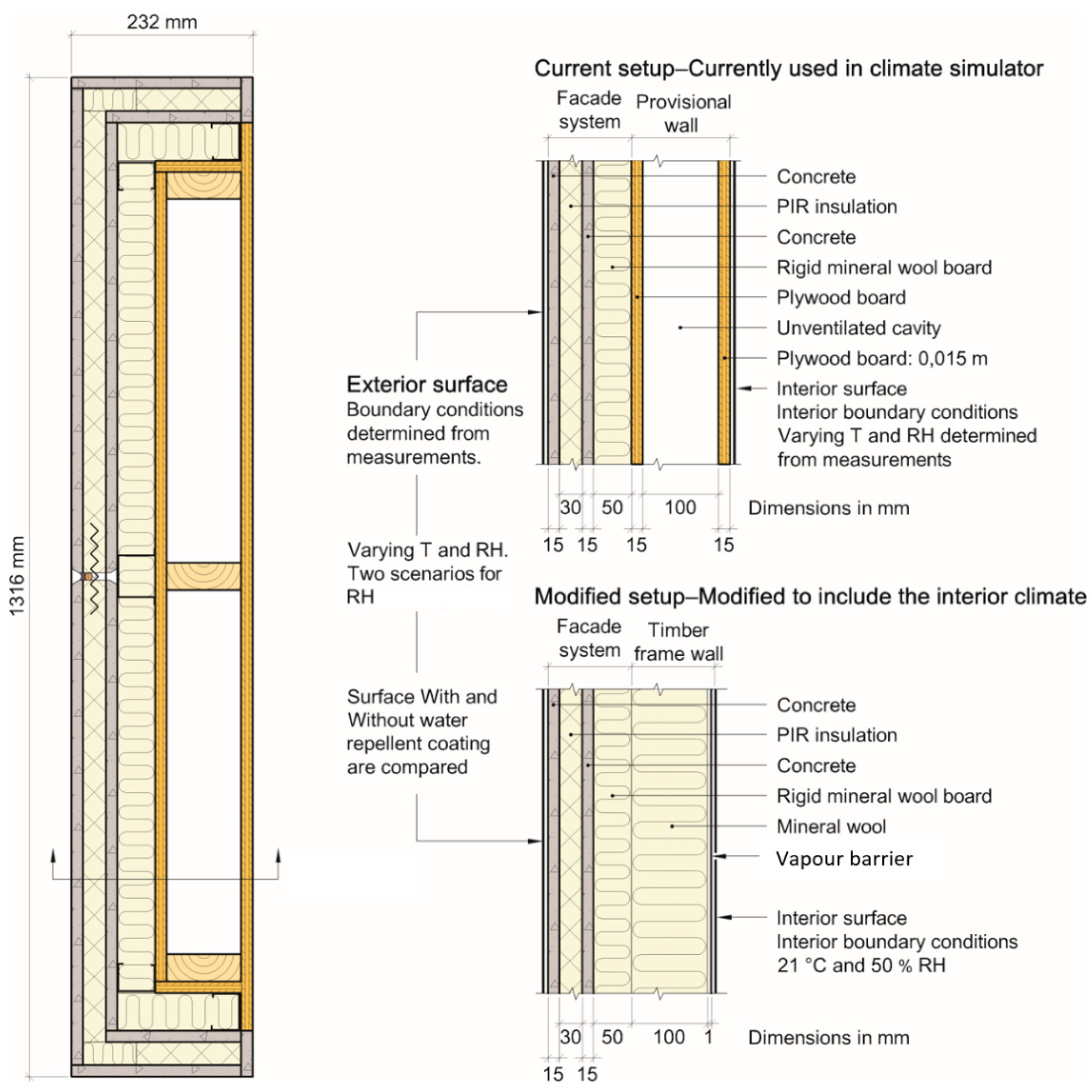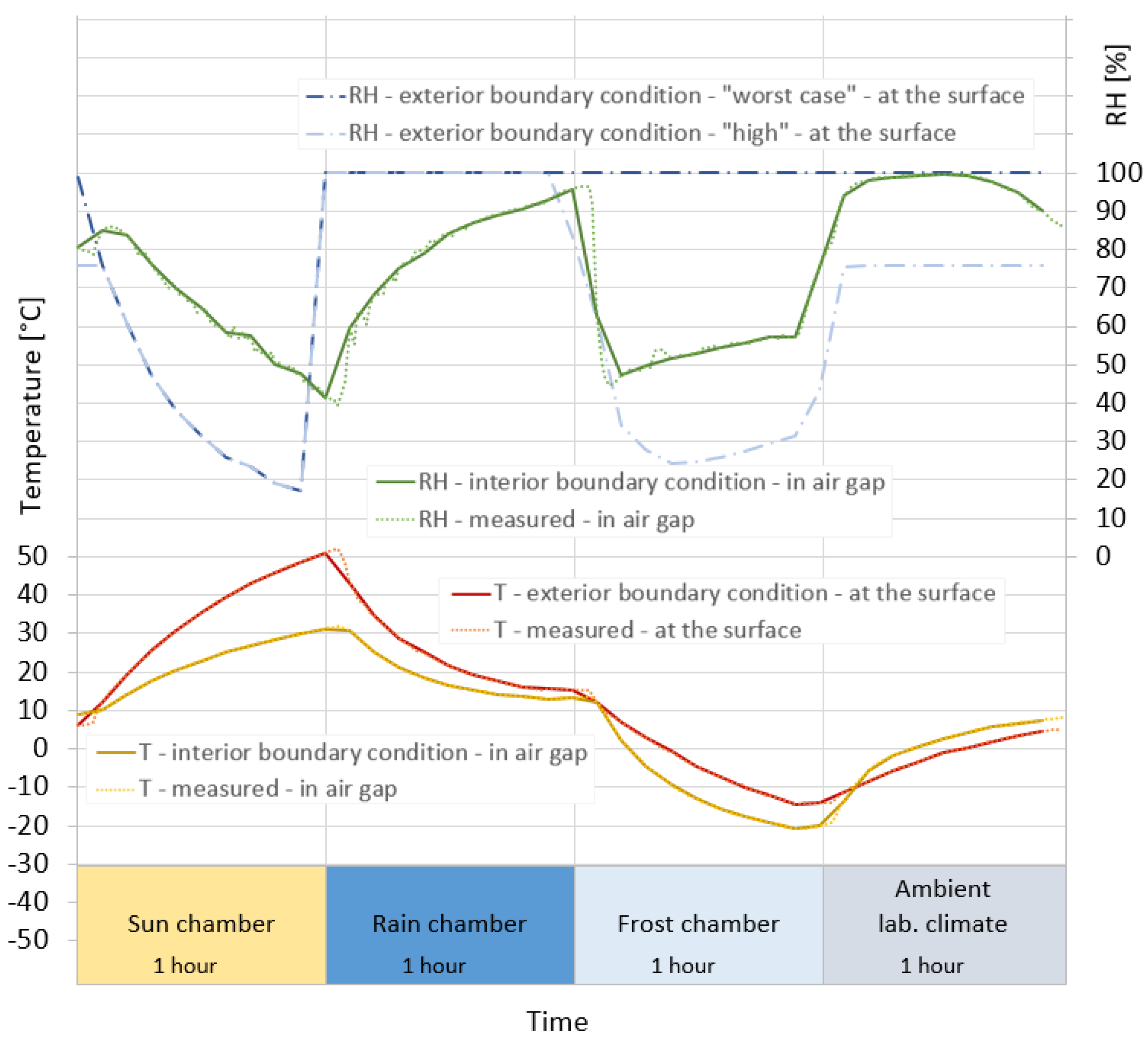1. Introduction
Buildings are exposed to severe degrading factors throughout their lifetime, including solar radiation, high temperatures, wind-driven rain, freeze–thaw, and chemical substances [
1]. More intense rainfall events and increased annual precipitation are predicted in many geographical regions with cold climates owing to climate change [
2]. When a building’s “weather skin” fails to withstand climatic exposures over time, failures/leaks occur. Moisture penetrating the building envelope can lead to a range of damages, influence occupants’ health and comfort, incur extensive costs, and reduce the thermal performance of the envelope [
3,
4,
5,
6]. As damage can be prevented by selecting durable materials and façade systems, accelerated ageing tests have emerged as an important tool to promote sustainable buildings [
7].
Accelerated artificial ageing involves subjecting materials to climatic factors similar to those experienced through a building’s service life, but at a high intensity over a shorter period. In this way, the vulnerability of building products or façade systems can be tested within a reasonable time. Many different types of climate ageing laboratory apparatuses have been developed for this purpose [
1], including the climate simulator described by Nordtest NT Build 495 [
8]. The method is intended to expose the materials and components used in a building envelope to ultraviolet (UV) light, heat, water, and frost. During the accelerated artificial climatic ageing test NT Build 495, the specimens are positioned vertically in a rotating carousel and exposed to the four degrading factors repeatedly for one hour each (see
Section 2.2). The method does not include resistance to mechanical loads such as hail, which might be an issue for Exterior Thermal Insulation Composite Systems (ETICS) [
9]. Other relevant degrading factors omitted from the test are environmental pollution and dirt deposition, mould growth, vibrations, and wind [
3].
The SINTEF, as the leading test facility in Norway, has used the NT Build 495 climate simulator as a standardised exposure method for building materials and components for several decades. Comparing test results to experiences from field investigations has contributed to substantiating the applicability of the test method [
1,
6]. The test is primarily used to consider whether materials and components can withstand climatic exposures as harsh as those they may be subjected to in real life; if the exposure in the simulator is endured, the durability is likely to be sufficient. Improvements are called for if damage occurs after a short exposure time. Through repetitive testing, improvements to the material composition or component design can be investigated and compared with the initial results. Wind barriers, wood shingles and façade claddings, underlayer roofs, tape for building purposes, brick, sealings, windows, and renders are examples of façade materials which through testing according to NT Build 495 have achieved a documented level of durability [
10,
11,
12,
13]. The test is also applied to façade systems such as ETICS because the outer surface is vulnerable to cracking owing to freeze–thaw [
6] and elevated temperatures caused by solar radiation [
14]. When exposed to severe driving-rain conditions, assemblies with only a single-stage protection against wind and rain are particularly vulnerable, as cracking of the exterior surface leads to leaks. Owing to the limited drying ability, even small cracks can cause moisture to accumulate in the underlying structure and lead to damage [
6].
Rainwater may also be transferred into the underlying structure by capillary conduction or diffusion; the latter may occur when the exterior surface is wetted by rain and subsequently heated by solar radiation. The uptake of rainwater at the surface depends mainly on the capillary properties of the exterior materials, and whether a water-repellent surface treatment is applied. The impact of these transfer mechanisms on the overall moisture performance of assemblies varies depending on the mass transfer properties which are often lacking, time-consuming, or expensive to measure, and may show large standard deviations for the same material [
15]. Numerical simulations are commonly used to investigate the drying ability of assemblies; however, results are often prone to large deviations because of large uncertainties in the mass transfer properties and the inability to realistically include the diffusion and suction contacts between material layers [
15].
In Norway, Technical Approvals authorized by SINTEF Certification, document to builders that a façade system is suitable for the Norwegian climate. The criteria to obtain a Technical Approval are mainly based on methods and criteria for assessing the performance given by EAD 040083-00-0404 [
16], but testing of durability properties according to NT Build 495 is additionally required. The NT Build 495 has been found to be an applicable test method in Norway [
6]; however, the test is currently carried out without a habitable climate on the indoor side of the specimen. Façade systems are subjected to degrading climatic factors on the exterior side and the temperature/relative humidity (RH) on the interior side is currently not controlled; that is, the temperature/RH on the interior side follows the fluctuations on the exterior side. Although this practice works adequately in most cases, it is necessary to investigate whether the interior climate should be controlled when moisture-sensitive assemblies are assessed—e.g., assemblies with only single-stage protection against rain intrusion.
In the authors’ opinion, omitting to control the interior climate (as in the current test setup) should not result in more moisture accumulation compared to a modified setup where the interior parts of the façade system are included, and the interior climate is controlled. To consider the need to change the current test methodology of NT Build 495 to control the interior climate, a complementary numerical analysis has been performed. This study investigates how moisture accumulation in a façade system exposed to accelerated artificial ageing is affected by the interior climate.
To address these general inquiries and uncertainties, the following research questions were raised:
To what extent does moisture accumulate in a façade system with single-stage weather protection when exposed to climate exposure in the climate simulator?
How does the interior climate in the climate simulator affect moisture accumulation in façade systems with single-stage protection?
Given the extent of the research field, certain limitations were determined:
This study concerns a façade system with single-stage protection against rain and wind. Assemblies with two-stage protection were not addressed.
In the hygrothermal simulations, we presumed that the façade system endured the accelerated ageing test without cracking of the exterior surface and that the mass transfer properties did not change over time owing to degradation.
Material properties (including mass transfer properties) were mainly obtained from the WUFI
®Pro material database [
17]; hence, they were not measured. The exception is the material properties of the polyisocyanurate-insulation (PIR insulation), which was defined based on input from the producer of the façade system.
The moisture content in the façade system or the degree of degradation occurring throughout the ageing test were not measured.
Hysteresis in the concrete moisture storage function was not accounted for in the numerical simulations.
Changes in material properties caused by degradation or chemical processes, such as curing, were not accounted for.
The simulations were not validated with physical measurements.
2. Theoretical Framework
2.1. Durability of Façade Systems
Façade systems are primarily subjected to accelerated ageing to assess the durability of an exterior surface because the ability to withstand UV light, heat, water, and frost are crucial to a building’s climate shell/weather skin. However, all adjoining materials must collectively withstand climatic exposures to achieve the best possible durability.
Façade systems erected in accordance with the principle of two-stage tightening is considered a robust solution; that is, weather protection by a separate rain shield (cladding) and air/wind tightening (wind barrier). Two-stage tightening is crucial in climates with severe driving-rain exposure [
18] as in large parts of the west coast of Norway [
6]. The risk of moisture-related damage decreases when moisture penetrating the exterior surface (the rain shield) is allowed to dry effectively through a ventilated air gap. Façade systems with only single-stage protection against wind and precipitation (e.g., ETICS) are much more vulnerable to damage because cracking of the exterior surface can lead to leaks. Due to their limited ability to dry, even small cracks can cause moisture to accumulate in the underlying structure and lead to damage [
6]. Therefore, the durability of the exterior surfaces of façade systems with only single-stage protection is of major importance. A known cause of failure is the stress that occurs when adjoining materials expand and contract differently owing to temperature changes [
19,
20]. For ETICS, the critical factors in this context are the stiffness and thermal expansion coefficient of the thermal insulation along with the thermal expansion coefficient of the exterior rendering. Restrained movements of the components can result in bending moments, particularly when the insulation material has a high stiffness value [
21]. Other major causes of degradation are frost weathering during water-to-ice volume expansion, photodegradation caused by solar radiation, and hail [
9]. These and several other climate exposure factors were further addressed by [
1].
Considering only natural weather ageing to gain knowledge of the durability of materials or components is often unsatisfactory because the natural outdoor climate ageing processes take time [
1]. Accelerated climate ageing tests are an option to obtain sufficiently fast and economical results. Accelerated ageing is considered a valuable practice to avoid extensive building damage owing to missing or too low resistance to climate exposure [
1]. A number of accelerated climate ageing apparatuses exist and can be utilised in the laboratory according to different test methods and standards [
1,
22]. The purpose of accelerated climatic ageing tests is, however, not to provide an accurate estimate of service life expressed in terms of a number of years; it is to benchmark the ageing properties of different materials, systems, and techniques [
6].
2.2. Accelerated Artificial Ageing of Façade Systems
To assess the durability of façade systems/assemblies, test equipment further referred to as the climate simulator is much-applied. The accelerated artificial climatic ageing in the climate simulator is described by Nordtest NT Build 495 [
8]. The test was developed 50 years ago by Byggforsk (which later merged with SINTEF). After many years of experience including comparisons with natural climatic ageing of façade materials, Byggforsk developed a method description which was later approved as the Nordtest method [
8].
During the accelerated artificial climatic ageing test NT Build 495, specimens are positioned vertically in a rotating carousel and exposed to four degrading factors repeatedly for 1 h each (see
Figure 1). In the first chamber, UV radiation is applied using fluorescent UV tubes with a relative spectral distribution in the UV band close to that of global solar irradiance. The black panel temperature rises to its designated temperature (normally 63 ± 5 °C) in 45 min from the beginning of exposure to UV light and heat radiation. If required, the black panel temperature may be chosen as 35 ± 5 °C, 50 ± 5 °C, or 75 ± 5 °C, cf. ISO 4892. The temperature is controlled using infrared halogen lamps. In the second chamber, the specimens are wetted with a spray of demineralised water. The suggested strain was 15 ± 2 L/m
2·h, but various spraying conditions may be used if required. To allow water to drip off, the spraying is terminated 10 min before the specimens rotates in to the third chamber. In the third chamber, an air temperature of −20 ± 5 °C is suggested, but other specified air temperatures may be used if registered and reported. In the fourth chamber, the specimens are thawed at a laboratory climate of 23 ± 5 °C and 50 ± 10% RH.
The results of the test include information on the changes occurring during the test, the scale of the changes, and the time of occurrence. The results are assessed qualitatively, and the performance properties is often a change in performance properties—change in appearance of the specimens during the test or signs of degradation; for example, cracks, loss of gloss, or delamination.
Testing of façade solutions according to NT Build 495 [
8] is currently carried out without the interior parts of the walls and without a habitable climate on the indoor side of the specimen. It is uncertain how this affects the moisture transfer at the surface and the moisture performance of the tested specimens.
Although this might be a shortcoming in the current test setup, it is a setup much-applied to assess the durability of exterior surfaces. E.g. D’Orazio et al. [
23] investigated the durability of an EPS-based lightweight prefabricated construction system without focusing on the impact of the interior climate. Griciutė et al. [
22] compares water adsorption of ETICS samples with samples on plaster strips but does not focus on the interior parts of the wall or the interior climate. Franzoni et al. [
24] performed accelerated ageing tests to investigate the durability of a new prefabricated external thermal insulation composite board for building retrofitting without focus on the interior parts of the walls nor the indoor climate. In addition there are many examples of studies focusing on accelerated artificial ageing of small samples, such as [
25,
26].
Daniotti et al. [
3] on the other hand, assessed the degradation evolution and the loss in hygrothermal performance of ETICS using a test setup which included all layers of the wall and a laboratory climate on the indoor side. They observed decreasing thermal resistance due to an increase of water content caused by rain penetration. They concluded that ageing, and moisture, whose content within layers is increased by ageing, affect dynamic thermal performances. The main degrading factor highlighted in this study, however, seems to be the thermal shock and dilatation-contraction events which causes blistering and deformation of the top coat. Gonçalves et al. [
14] assessed the degradation and hygrothermal performance of the vacuum-insulation panel (VIP) based ETICS using a test setup which included all layers of the wall and a laboratory climate on the indoor side. They compared the test procedures defined in [
16] with a new procedure to simulate solar radiation conditions. The new procedure caused defects such as loss of flatness and finishing coat microcracking, which were not found after the standard procedures, revealing the importance of studying the radiation effect on ETICS systems.
Other noteworthy studies need also be mentioned. E.g. Maia et al. [
27] investigated the hygrothermal performance of a new thermal aerogel-based render applied as a component of a multilayer coating system by measuring relevant material properties and conducting hygrothermal simulations. The study highlights the importance of applying a finishing coating with low capillary absorption to reduce the water content in the inner layer and consequently the impact on the U-value of the façade. The numerical simulations highlighted that the hygrothermal risk increased in more severe climates (such as Hannover in Germany compared to Porto in Portugal) but does not focus on colder climates such as Norway. The importance of taking into account freeze–thawing ageing in colder and moderate climates is however assessed by Maia et al. [
28].
2.3. Moisture Transfer in Façade Systems with Single-Stage Protection
Façade systems with only single-stage protection against wind and rain are considered particularly vulnerable to moisture damage because cracking of the exterior surface can lead to leaks and cause moisture to accumulate in the structure. Moisture from the exterior surface might also be transferred inward to the thermal insulation by diffusion when a wet surface is subjected to solar radiation. Without a ventilated air gap behind the exterior surface to enable moisture to dry effectively, moisture might accumulate in the thermal insulation behind the outer layer(s) and cause damage.
Façade systems tested in the climate simulator [
8], are subjected to the degrading climatic factors on the exterior side, since the purpose of the test is to detect material degradation caused by exterior climatic exposures. The climate on the interior side is currently not controlled, as it is not within the purpose of the test to assess the overall heat resistance, general moisture transfer or durability of the interior parts of the structure. However, because the inward diffusion of moisture (caused by temperature differences) might be affected by the interior temperature, it might be necessary to control the interior climate when façade systems with only single-stage protection are tested.
In this study, we sought to evaluate the current test setup to determine whether the interior climate should be controlled. Omitting to control the interior climate (as in the current test setup) should not lead to more moisture accumulation compared to a modified test setup where the interior part of the wall is included and the indoor temperature is controlled.
2.4. Hygrothermal Simulations of Façade Systems Subjected to Accelerated Ageing
The ageing and degradation of materials and components cannot be meaningfully investigated by means of numerical simulations only [
3]. To gain information on the durability, testing by either natural ageing or accelerated artificial climatic ageing must be carried out [
1]. In this study, however, the objective was to investigate the moisture transfer from the exterior surface (exposed side) through the concrete and into the thermal insulation to determine whether it is necessary to control the interior climate in the climate simulator. As a theoretical approach, we assumed that the façade system was subjected to accelerated ageing for 12 months without cracking of the exterior surface and without significant changes to the hygrothermal properties. In this way, we may investigate the possible moisture accumulation within the thermal insulation, not exclusively caused by cracking of the exterior surface, and determine how the moisture transfer is affected by the interior climate.
2.5. Calculating the Capillary Absorption of Rain
To calculate the capillary absorption of rain, WUFI
®Pro [
17] uses two material properties:
Dws (moisture diffusivity coefficient for “suction” (m²/s)) and
Dww (moisture diffusivity coefficient for redistribution (m²/s)). The
Dws represents the capillary uptake of water when the surface of a sample element is completely wetted such as during a rain event. The suction transport is dominated by the larger capillaries because their lower capillary tension is more than compensated for by their markedly lower flow resistance. The
Dww describes the dispersal of absorbed water when the wetting is complete; that is, when no more water is taken up and the water in the material is further distributed. For a building component, this corresponds to moisture transport when rain is absent. The redistribution is then dominated by the smaller capillaries because their higher capillary tension draws the water out of the larger capillaries (WUFI
®Pro online help [
17,
29]). Moisture absorption from rain is neglected in WUFI
®Pro if the “adhering fraction of rain” is set to 0 or if the rainfall is lower than 0.1 mm (it is then assumed that the rain evaporates before it is drawn into the surface). Rain is also used to determine whether capillary absorption (
Dws) or capillary redistribution (
Dww) is dominant in a building component. That is, for time steps where the climate data show rain,
Dws will be used to calculate the capillary transport processes in the component. When rain is absent or very low,
Dww is used. The
Dws is generally significantly larger than
Dww because redistribution is a slower process that occurs in small capillaries with high flow resistance (WUFI
®Pro online help [
17,
29]). It is uncertain how well suited the software is to realistically replicate the uptake and distribution of rain in a multi-layered façade system with a concrete surface repeatedly subjected to rain events for a long period of time.
5. Discussion
This study investigates the risk of moisture accumulation in a multi-layered façade system exposed to accelerated ageing in the climate simulator according to NT Build 495 [
8], and considers the need to change the current test setup by controlling the interior climate. The results and answers to the research questions are discussed in the following section.
5.1. Moisture Accumulation in a Façade System Exposed to Accelerated Ageing
The hygrothermal simulations show that moisture may accumulate in the thermal insulation; however, this is strongly dependent on the concrete quality and whether a water-repellent surface treatment is applied. The C12/15 and C35/45 concretes have the greatest ability to transfer moisture by capillary action (large liquid transfer coefficients) and result in the largest moisture accumulation. The typical application of these concretes is not stated in the WUFI®Pro material database, and the correspondence to the concrete in the façade system is unknown. However, the high moisture uptake suggests that they will not work well in a façade with single-stage protection.
The results also show, in line with previous research [
30], that applying a water-repellent surface treatment contributes to prevent moisture accumulation in the façade system. When rain is allowed to penetrate the surface (no water-repellent surface treatment is applied), all relevant concrete characteristics result in high moisture content in the PIR insulation. When a surface treatment is applied (liquid uptake of rain is excluded), the results vary more. The MASEA and Old concretes results in a low moisture content, the waterproof concrete has a low or a moderate moisture accumulation depending on the RH-scenario, and the C12/15 and C35/45 concretes results in high moisture content.
Comparing the results for the C12/15 and C35/45 concrete qualities with and without a surface treatment, is interesting. When rain is allowed to penetrate the surface, the concretes result in lower moisture accumulation in the PIR insulation than when rain is excluded. This behaviour is caused by the mathematical model and the procedure for calculating the capillary absorption of rain. In short, when rain is applied to the component for capillary absorption, the amount of water absorbed during the time step depends on the capillary properties of the surface material, the current saturation state of the material, and the amount of rain available for absorption. Rain is also used to determine whether capillary absorption or capillary redistribution processes are currently dominant in the building component. During the time steps rain is applied, the liquid transport coefficients for suction are used to compute all the capillary transport processes in the component. Otherwise, the liquid transport coefficients for redistribution are used. Due to the fact that the surfaces of the two types of concrete are already close to saturation when rain is applied for adsorption, most of the rain runs off instead of being absorbed. The rate of the moisture transfer in the other capillary material layers in the component, however, is increased. As a result, more moisture is transferred from the PIR insulation towards the interior side during rain events, resulting in a somewhat lower final moisture content in the PIR insulation despite the lack of a water-repellent surface treatment. It is uncertain whether the qualities of these concretes are suitable for the exterior surface of façades with only single-stage protection because of the risk of degradation by freezing and thawing.
5.2. Controlling the Interior Climate
Artificial accelerated ageing of building materials and products are performed according to NT Build 495 [
8]. The test is applied to façade systems to assess the durability of their exterior surfaces as withstanding UV light, heat, water, and frost and are crucial to a buildings’ climate shell/weather skin. In the current test setup, façade systems are mounted on a provisional wall and subjected to degrading climatic factors on the exterior side. One concern with the current test setup is that the façade systems are tested without the interior parts of the wall assemblies and without a habitable indoor climate. The concern is that that this setup might negatively affect the moisture performance. However, the simulations show that the current test setup results in lesser moisture accumulation in the thermal insulation compared to that of the modified test for all the investigated types of concrete. This is mainly because the interior temperature in the current test setup follows variations in the exterior surface temperature more closely than in the modified setup where the interior parts of the wall is included and the indoor climate is controlled at 21 °C. The interior parts of the wall also limit the drying to the interior side to a certain extent. According to Daniotti et al. [
3], more water absorption detriments both ageing and thermal performance of ETICS.
5.3. Limitations of The Study
In this study, we assess the possible moisture accumulation in the PIR insulation in a façade solution that may occur without damage/degradation at the exterior surface. It was therefore assumed that the façade system was subjected to accelerated ageing for 12 months without cracking of the exterior surface and without significant changes to the hygrothermal material properties. To gain information on the durability, testing by either natural ageing or accelerated artificial climatic ageing must be carried out.
Modelling the complex coupled heat and moisture transfer processes in building components always involves simplification of reality. Some materials (e.g., concrete) do not conform to the simplified transport equations and change their material data depending on their present and past moisture content. Materials with a pronounced hysteresis in their moisture storage function (e.g., concrete) may not be sufficiently described using an averaged moisture-storage function. The total moisture transfer resulting from the combination of liquid and vapour transport processes under varying thermal conditions, as in the climate simulator, is also difficult to calculate because the two flows cannot be divided in laboratory experiments. The errors caused by these general inaccuracies may be negligible or serious. To determine the reliability of the calculations, the results should be compared with measurements.
The boundary conditions applied in the hygrothermal simulations were determined based on measurements of temperature and RH in the climate simulator. Due to the fact that the RH humidity at the exterior surface (exterior boundary condition) was lacking, two different RH scenarios were determined from measurements of RH in the air gap behind the test samples: “Worst case” and “High”. The two determined scenarios were considered conservative; that is, higher than what the measurements indicated, in particular during exposure to the ambient laboratory climate. The two conservative scenarios were considered appropriate for the scope of this study; however, the moisture accumulation may be somewhat overestimated in this study because of this inaccuracy. If the purpose of the simulations had been to determine the amount of moisture accumulation more precisely, more detailed measurements of the boundary conditions and material properties would have been necessary.
The material properties of the products in the façade system in this study have not been documented. Ideally, the material properties should have been determined experimentally under similar boundary conditions as in practical use. This was beyond the scope of this study. Therefore, five different types of concrete derived from the WUFI®Pro material database were compared. The correspondence of these concretes to the actual material properties of the concrete in the façade system is unknown.
As discussed in this chapter, there were inaccuracies in the calculations caused by the limitations in the hygrothermal model, the determination of boundary conditions, and the lack of documented material properties. A main concern is the unknown material properties of the concrete and the modelling of rain absorption at the surface. The ability of the simulation software to realistically replicate the moisture transfer in multi-layered façade systems exposed to rain events over long time periods is questionable. Although these inaccuracies must be acknowledged when interpreting the calculated moisture accumulation, they are considered to be of less importance for the main results and conclusions in this article.
